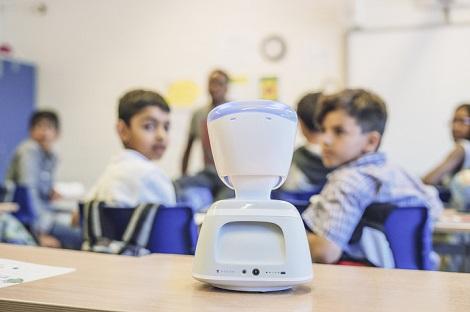
Published on: 08/10/18
Acting as the child’s eyes, ears and voice in the classroom the AV1 robot can change children’s lives. Harriet Gridley at the developer No Isolation tells us more.

Published on: 08/10/18
Can you tell us about AV1 and who it helps?
Many children diagnosed with a long-term illness have to miss long periods of school, and miss out on their social development as a result.
AV1 is a telepresence robot designed to reduce loneliness and social isolation for these children. It works as an avatar, and acts as the child’s eyes, ears and voice when they can’t attend school in person. Children can take part in the social aspect of their lives, making reintegration in school upon recovery much easier.
Who’s using AV1? Who pays for it?
Users range in age from six years to 25 years old. The reasons vary but all children using AV1 have had a diagnosis that’s resulted in absence from their everyday lives.
AV1 can be bought privately or rented privately (with a minimal rental period of three months) but mostly AV1s are administered to those who need it from schools, municipalities, charities and local authorities who buy or rent AV1 themselves.
How does the robot actually work?
The AV1 is put in the classroom and in places the child would be at if they were not absent. The child connects to the robot through the AV1 app, providing a one-way video stream to the child’s tablet or smartphone.
From their phone/tablet, the child can turn the head 360 degrees, and show their emotions through the robot’s eyes. They can raise their hand in class through the app or indicate that they don’t want to participate in class, taking the position of ‘observer’.
AV1 isn’t just for school hours, children can attend parties and other events that they’d miss out on due to their condition.
What benefits has it brought to children?
AV1 has brought children who are prone to long periods of social isolation and opportunity to have more social contact and normalise their involvement in their everyday lives.
A child’s illness no longer limits them to a confined space and they can interact with many different people. We have also found reintegration into school becomes easier for children if they’ve stayed in touch with their classmates during their absence.
What’s next for AV1?
There are currently 72,000 children with a long-term illness in the UK alone, and we want to help every single one of them. We want AV1 to be available to everyone who needs it so that social isolation is not longer a factor in their recovery. The Department of Education and its Alternative Provision Fund now have a project that will provide 90 AV1s to children across the country. This is a very positive start.